This Museum, founded in 1928, portrays the life and the naval achievements of the people of this town in the last three thousand years, from the prehistoric period up until the beginning of the 20th century. The exhibits are donations of the people of Galaxidi.
The building that now houses the Maritime Museum of Galaxidi was constructed in the 1830's and until 1870 it functioned as a carpet industry where the sailors' wives were occupied. Later, it housed the Municipality of Galaxidi and in 1932, the Maritime Gallery of the town. In 1979 the archaeological finds from the area of Galaxidi were transfered from the Museum of Delphi, where they had been kept, to the Maritime Museum and were exhibited in one of its rooms. In the other rooms of the building the exhibits of the Maritime Museum are displayed.
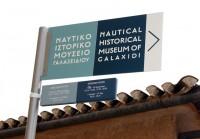
Galaxidi: Nautical Museum Sign
Information on opening hours: June 1-September 30, 10:10 - 13:30 and 17:30 - 20:30
October 1 - March 31, 10:10 - 16:15 |
|
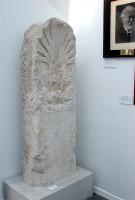
Galaxidi: Tombstone with palmette finial (3 century B.C.)
Incised are the names of the deceased
Kleodamos
Xeno
[D]amotima
Cemeteries
Two ancient cemeteries and some isolated tombs have been excavated in the area of Galaxidi. The first one is situated in the Geometric Settlement at Aghios Athanassios; the second one, dated to Hellenistic and Roman times, lies within the modern town of Galaxidi. In the first one, the dead were found placed on their side, knees pressed to the chest. In the second one, 35 tombs of all types were found; some of the dead must have been placed in a coffin or on a bed, since bronze and iron nails were found around them. Rich funerary offerings were found in a number of graves.
Two caves were converted during the Roman and Early Christian Periods into chamber tombs, one in Kendri and the other near Kalafatis Beach.
|
|
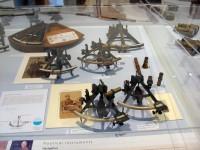
Galaxidi Nautical Museum: Navigational Instruments - Sextants |
|
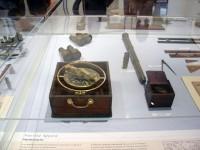
Galaxidi Nautical Museum: Navigational Instruments - Compass |
|
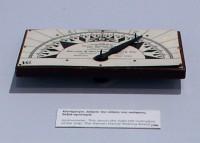
Galaxidi Nautical Museum: Navigational Instruments - Inclinometer
It measures the right-left inclination of the ship. The Hansen Handy Bearing Board |
|
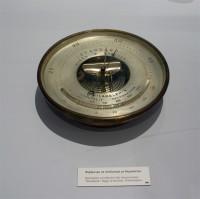
Galaxidi Nautical Museum: Navigational Instruments - Barometer combined with thermometer. “Standard”, Riggs & Brother, Philadelphia
Forecasting the weather
In the time of the sailing ships, no weather forecasts were broadcast, nor were there any radio wireless communications (actually, no wire communications either), so forecasting the weather, being always of primary importance to the sailor, was left to his own experience, using simple instruments. The barometer, that measured the atmospheric pressure; the barograph, that recorded the pressure continuously; and the thermometer, that measures the temperature of the surrounding air, were tyical instruments found on sailing ships.
|
|
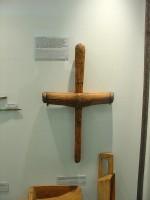
Galaxidi Nautical Museum: Shipbuilding Tools – Caulking Mallet
A mallet is a wooden hammer which was used for various jobs. For caulking, they had specially made mallets. Caulking was the waterproofing of the seams of the outside planks and the ship’s deck. Specialized workmen, the “caulkers”, used a fine string, slightly coated with pitch, which they pushed into the seams of the planks with special tools, caulking irons, which they hit with the mallet. The experienced caulkers could tell, by the sound of the striking mallet, whether the caulking was successful.
|
|
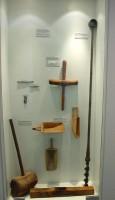
Galaxidi Nautical Museum: Various Shipbuilding Tools |
|
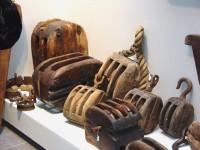
Galaxidi Nautical Museum: Tools - Blocks
Blocks are wooden pulleys, necessary on all sailing ships. The only source of power on a sailing ship, apart from the wind, was human muscle power. To raise and move the sails, to hoist up the cargo and anchor and to do other heavy jobs, this muscle power was multiplied by using blocks, and these, according to the specific task, were single, double, triple or quadruple. |
|
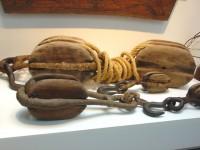
Galaxidi Nautical Museum: Tools - Blocks |
|
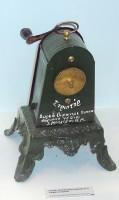
Galaxidi Nautical Museum: Tools - Rope-twister
Special hand-operated machine to twist ropes
|
|
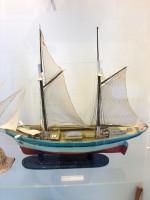
Galaxidi Nautical Museum: Sailing Ship Model |
|
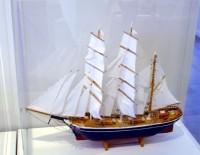
Galaxidi Nautical Museum: Sailing Ship Model |
|
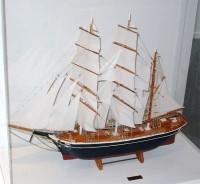
Galaxidi Nautical Museum: Sailing Ship Model |
|
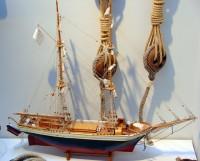
Galaxidi Nautical Museum: Sailing Ship Model |
|
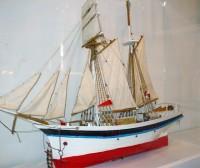
Galaxidi Nautical Museum: Sailing Ship Model |
|
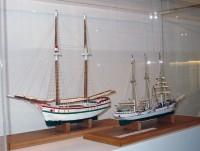
Galaxidi Nautical Museum: Sailing Ship Models |
|
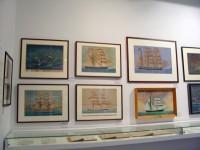
Galaxidi Nautical Museum: The Painter, Spyros Vasiliou, and the Galaxidi Museum
Spyros Vasiliou (1902/3-1985), a most prominent Greek painter, was born and grew up in Galaxidi. His talent was recognized from an early age, and he was encouraged by members of the local community to study at the School of Fine Arts in Athens. As a young man, he won a prize for his designs for the frescoes of Agios Dionysios the Areopagite, in Athens, which allowed him to travel widely throughout Europe.
In 1934 he published a collection of drawings of Galaxidi sailing ships together with a text, including poems, full of nostalgia for the maritime community.
In 1962, when he was already very well known, with many exhibitions in Greece and abroad, he undertook the arranging of the paintings of the sailing ships of the Galaxidi Nautical Museum that was then extended.
With the opportunity of events honoring the great painter’s memory in 1996, his family donated the works exhibited in the Museum, part of which is shown in this photo. |
|
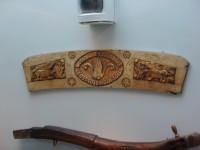
Galaxidi Nautical Museum: Parts Of Ships
This curved wood sign was part of a ship built in 1908 |
|
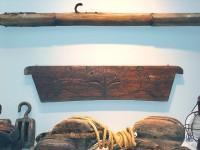
Galaxidi Nautical Museum: Parts Of Ships
This curved wood sign was part of a ship built in 1911 |
|
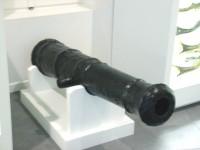
Galaxidi Nautical Museum: Parts Of Ships - Canon |
|
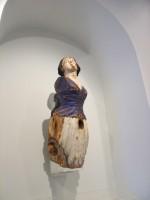
Galaxidi Nautical Museum: Parts Of Ships - Figurehead |
|
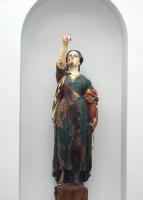
Galaxidi Nautical Museum: Parts Of Ships - Figurehead |
|
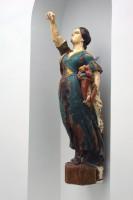
Galaxidi Nautical Museum: Parts Of Ships - Figurehead
Same as in previous photo, different angle |
|
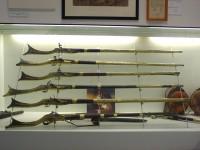
Galaxidi Nautical Museum: Weapons - Firearms of the Greek Revolution
Against Turkish rule, 1821-1828 |
|
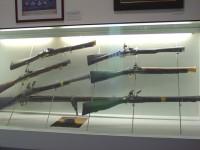
Galaxidi Nautical Museum: Weapons - Firearms of the Greek Revolution
Against Turkish rule, 1821-1828 |
|
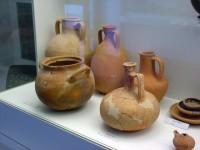
Galaxidi Nautical Museum: Ancient Finds - Pottery |
|
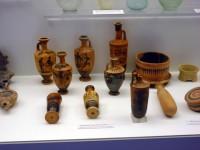
Galaxidi Nautical Museum: Ancient Finds - Pottery
From Classical Times |
|
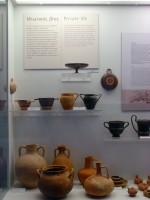
Galaxidi Nautical Museum: Ancient Finds - Pottery |
|
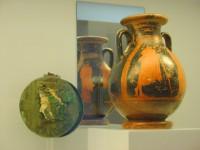
Galaxidi Nautical Museum: Ancient Finds - Pottery - Red-figure Pitcher For Perfumes. Also, next to it, a Bronze folded mirror bearing the relief representation af a woman's head.
Each side of the ceramic pitcher depicts a bearded man conversing with a youth (front) and a woman (back). Created by the so-called “Syracuse Painter” |
|
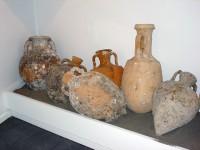
Galaxidi Nautical Museum: Ancient Finds - Pottery
Retrieved from the seabed around Galaxidi, from ancient shipwrecks |
|
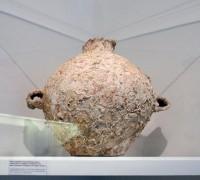
Galaxidi Nautical Museum: Ancient Finds - Pottery - Two-handed Amphora of the Proto-Helladic Period, 2600-1900 B.C.
It was found in the sea of Anemokambi cove, coming from an ancient shipwreck. |
|
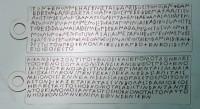
Galaxidi Nautical Museum: Ancient Finds - Two Bronze Plates With Inscriptions
In the area of Aghios Vlassis, two bronze plates with inscriptions were found in 1848, which ended up in the British Museum. They are dated in the first half of the 5th century B.C. and are extremely important, not only for the region, but for the whole of Greek History.
The first one refers to the participation of the Chaleians in the colonization of Southern Italy by the Locrians, and the second one records an agreement between the cities of Chaleion and Oiantheia concerning the protection of navigational rights or, according to another interpretation, the sharing of spoils from piracy. These inscriptions reveal a well developed constitution of the cities in the region, with laws, judicial authorities and specific magistrates.
|
|
|



